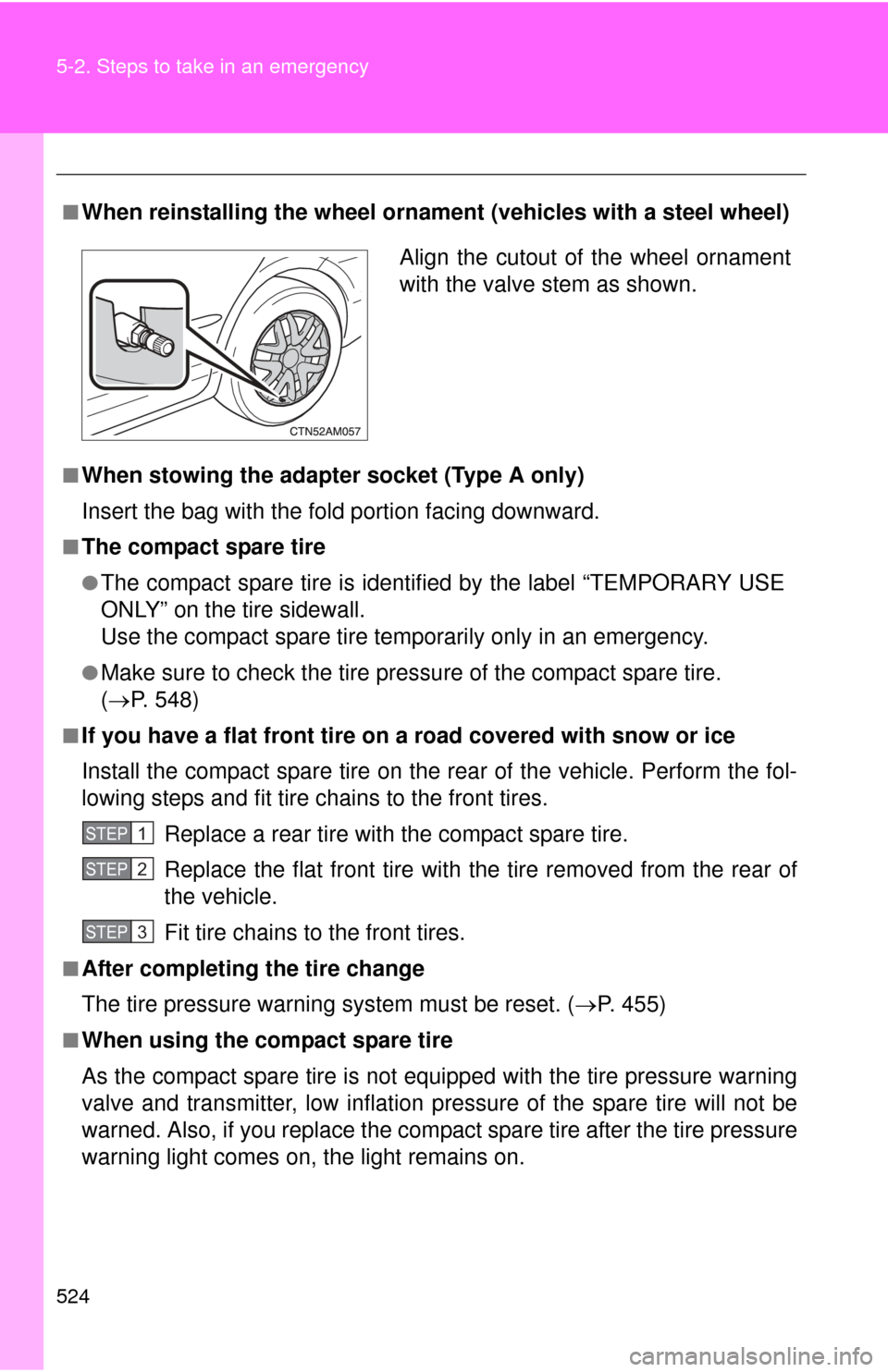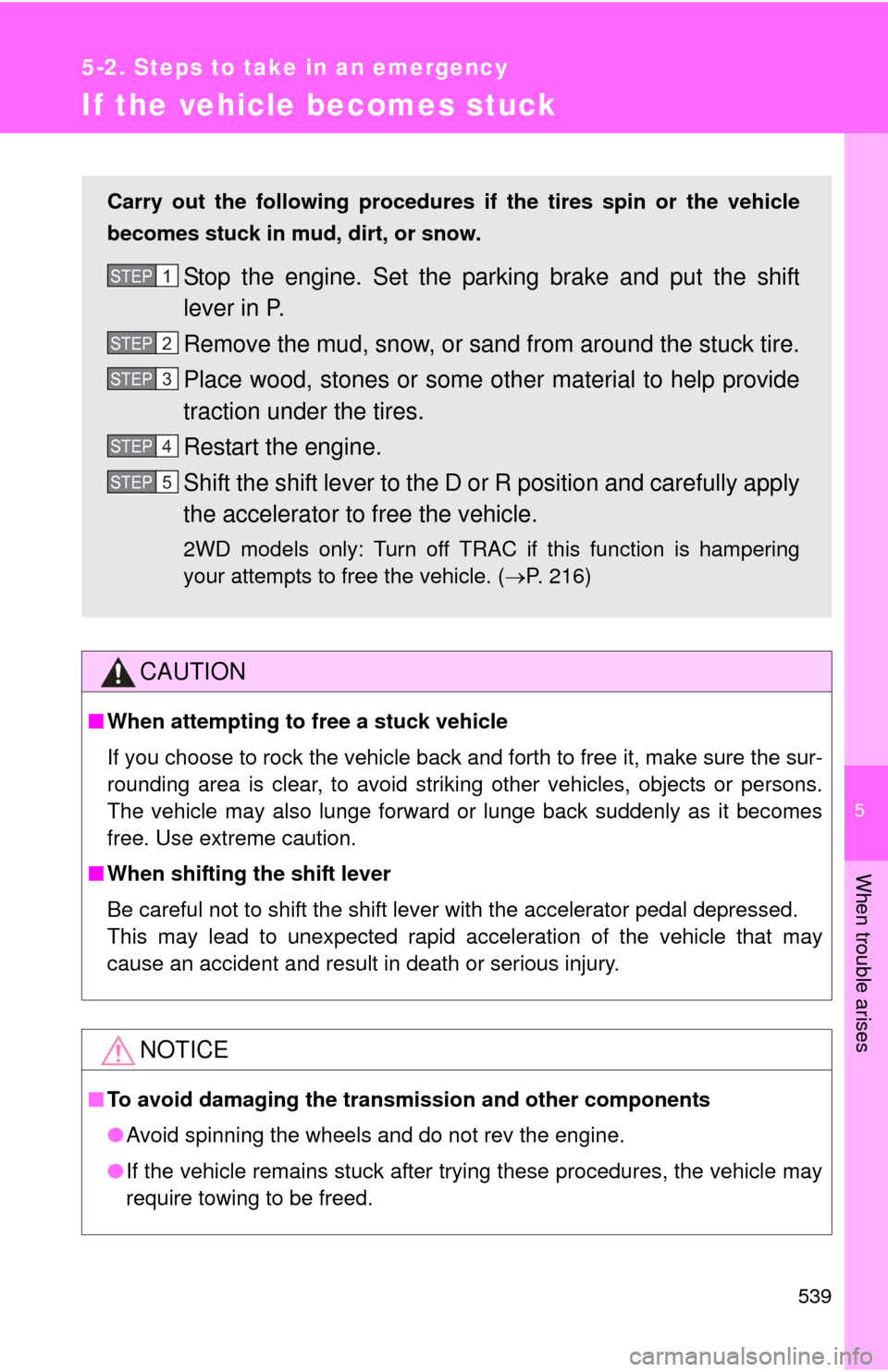Page 523 of 592
5
When trouble arises
523
5-2. Steps to take in an emergency
Lower the vehicle.
Firmly tighten each nut two or
three times in the order shown in
the illustration.
Tightening torque:
76 ft•lbf (103 N•m, 10.5 kgf•m)
Stow the flat tire, tire jack and all tools.
Stowing the flat tire
Wrap the flat tire in the tire bag
and stow temporarily in the lug-
gage compartment.
STEP3
STEP4
STEP5
Page 524 of 592

524 5-2. Steps to take in an emergency
■When reinstalling the wheel ornament (vehicles with a steel wheel)
■When stowing the adapter socket (Type A only)
Insert the bag with the fold portion facing downward.
■The compact spare tire
●The compact spare tire is identified by the label “TEMPORARY USE
ONLY” on the tire sidewall.
Use the compact spare tire temporarily only in an emergency.
●Make sure to check the tire pressure of the compact spare tire.
( P. 548)
■If you have a flat front tire on a road covered with snow or ice
Install the compact spare tire on the rear of the vehicle. Perform the fol-
lowing steps and fit tire chains to the front tires.
Replace a rear tire with the compact spare tire.
Replace the flat front tire with the tire removed from the rear of
the vehicle.
Fit tire chains to the front tires.
■After completing the tire change
The tire pressure warnin g system must be reset. ( P. 455)
■When using the compact spare tire
As the compact spare tire is not equipped with the tire pressure warning
valve and transmitter, low inflation pressure of the spare tire will not be
warned. Also, if you replace the compac t spare tire after the tire pressure
warning light comes on, the light remains on.
Align the cutout of the wheel ornament
with the valve stem as shown.
STEP1
STEP2
STEP3
Page 528 of 592

528 5-2. Steps to take in an emergency
NOTICE
■When loosening or tightening the spare tire clamp bolt (type A
only)
Do not use an impact wrench. Use the adapter socket and jack handle.
■Do not drive the vehicle with a flat tire
Do not continue driving with a flat tire.
Driving even a short distance with a flat tire can damage the tire and the
wheel beyond repair.
■Be careful when driving over bumps with the compact spare tire
installed on the vehicle
The vehicle becomes lower when driving with the compact spare tire
compared to when drivin g with standard tires. Be careful when driving
over uneven road surfaces.
■Driving with tire chains and the compact spare tire
Do not fit tire chains to the compact spare tire.
Tire chains may damage the vehicle body and adversely affect driving
performance.
■When replacing the tires
When removing or fitting the wheels, tires or the tire pressure warning
valve and transmitter, contact your Toyota dealer as the tire pressure
warning valve and transmitter may be damaged if not handled correctly.
■To avoid damaging the tire pressure warning valves and transmit-
ters
Do not use liquid sealants on flat tires.
■After taking out or stowing the spare tire (type A only)
Make sure to secure the tire carrier by tightening the clamp bolt to pre-
vent the holding bracket from hitting the under body of the vehicle during
driving.
■Using the tire carrier
●As the tire carrier is designed for use with the compact spare tire, it
cannot be used with standard tires.
●If the spare tire is flat, do not use th e tire carrier, as the tire may not be
held securely.
Page 539 of 592

5
When trouble arises
539
5-2. Steps to take in an emergency
If the vehicle becomes stuck
CAUTION
■When attempting to free a stuck vehicle
If you choose to rock the vehicle back and forth to free it, make sure the sur-
rounding area is clear, to avoid striking other vehicles, objects or persons.
The vehicle may also lunge forward or lunge back suddenly as it becomes
free. Use extreme caution.
■ When shifting the shift lever
Be careful not to shift the shift lever with the accelerator pedal depressed.
This may lead to unexpected rapid acceleration of the vehicle that may
cause an accident and result in death or serious injury.
NOTICE
■To avoid damaging the transmission and other components
●Avoid spinning the wheels and do not rev the engine.
● If the vehicle remains stuck after trying these procedures, the vehicle may
require towing to be freed.
Carry out the following procedures if the tires spin or the vehicle
becomes stuck in mud, dirt, or snow.
Stop the engine. Set the parking brake and put the shift
lever in P.
Remove the mud, snow, or sand from around the stuck tire.
Place wood, stones or some other material to help provide
traction under the tires.
Restart the engine.
Shift the shift lever to the D or R position and carefully apply
the accelerator to free the vehicle.
2WD models only: Turn off TRAC if this function is hampering
your attempts to free the vehicle. (P. 216)
STEP1
STEP2
STEP3
STEP4
STEP5